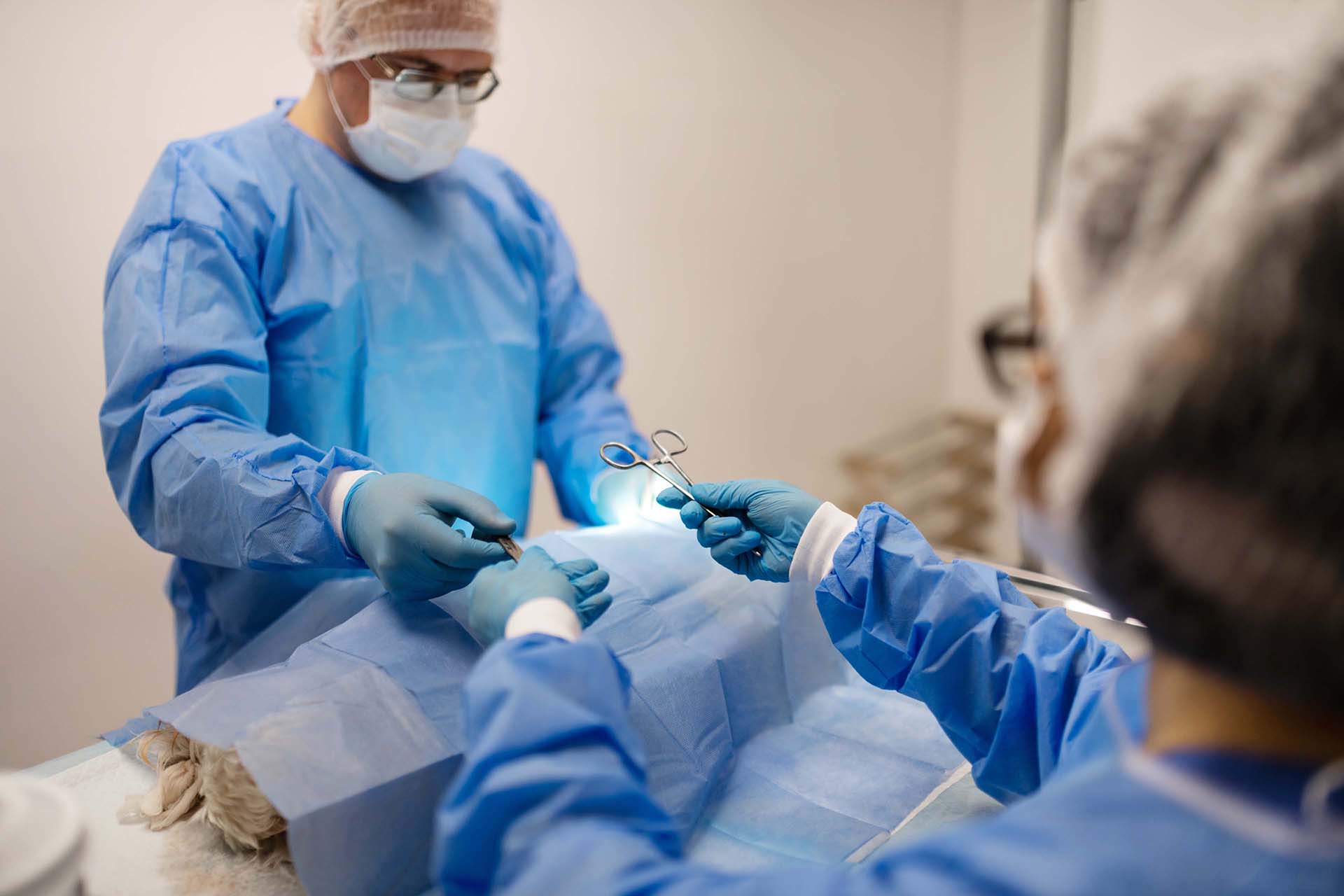Pet surgeries in Los Angeles
Does your pet need surgery? Rest easy for your pet as the team of experienced veterinarians at Veterinary Hospital Animal Clinic International takes care of his or her health.
With years of experience, our surgeons have performed both simple and highly complex surgeries on the brain, spine, and internal organs. We can perform the following types of surgical treatment:
- Abdominal and thoracic organs.
- Castration and sterilization.
- Neurosurgery.
- Urology.
- Dental surgery.
- Operations aimed at trauma and orthopedic pathologies - fractures, dislocations, hip dysplasia, medial dislocation of kneecap. Our veterinarians in Los Angeles perform osteosynthesis of varying degrees of complexity.
- Surgical treatment of wounds.
- Plastic surgery - rhinoplasty and other corrections for brachycephalic syndrome, plastic ears, eyelids, tail.
- Ophthalmologic operations.
- Surgical treatment of cancer. Our veterinarians perform a full examination of the tumor, perform surgeries including organ preserving ones, use chemotherapy and radiation exposure.
The operating room is carefully prepared for surgery. The air is disinfected with bactericidal recirculators. Surgical instruments are disinfected at 180 degrees: all bacteria, fungi and viruses perish within 1 hour.
Minimally invasive surgeries
Our veterinary hospital features an endoscopic surgical specialty. These are surgeries that do not involve tissue incision. They are performed using an endoscope, a device equipped with a tiny camera that allows you to control the precision of the procedure.
The essence of endoscopic surgery is to gain access to the organ through an endoscope. Manipulation, if possible, is done through natural orifices of the body, or through tiny punctures (laparoscopy). Our skilled surgeons perform endoscopic procedures such as:
- Sterilization and castration.
- Removal of foreign objects from the ear, nose, and digestive tract.
- Removal of polyps, myomas, blood clots, urinary stones.
- Surgical treatment of oncology and many others.
The presence of an endoscopic stand in our veterinary hospital allows specialists to perform a detailed examination of systems and organs in real time, take tissue for diagnosis and perform operations with no blood loss or trauma to surrounding tissues. This allows the animal to recover quickly.
How do we prepare the patient for surgery?
The success of surgical treatment depends on the preparation, which consists of the following steps:
- Clinical and laboratory diagnosis. This makes it possible to avoid complications at the moment when the animal is put under anesthesia. A list of examinations is compiled taking into account the type of surgery.
- Determination of the condition of the patient's vital organs: heart, lungs, kidneys and liver. Based on the information obtained during the examinations, our veterinarian will prescribe the safest method of anesthesia. If an ailment is found to temporarily interfere with the surgery, the veterinarian will proceed with treatment.
- Refraining from eating 6-8 hours before surgery applies to cats and dogs. Strict observation of this rule ensures that there are no problems with anesthesia. The thing is that if the stomach of the animal is full, during the operation the food masses can get into the airways and cause serious complications.
- Temperature Measurement.
It is important that the caregiver adheres to all of the doctor's recommendations received during the pre-surgery as well as the rehabilitation period.
Advantages of surgery at Veterinary Hospital Animal Clinic International
Our top veterinarians take comprehensive care of your pet's safety during all phases of the intervention:- Preparatory stage. Animal surgery is provided by a sterile operating room with the latest technology. All physiological indicators are monitored by the latest equipment. We prepare disposable consumables, if implants are needed, the highest quality products are chosen.
- Surgical procedure. Surgical table equipped with auto-heating system. Temperature control prevents hypothermia and promotes normal functioning of all organs and systems of the body.
- Anesthesia. Proven medications are used. They give analgesic and sedative effect after 30 seconds from the moment of application. Initially a sedative is administered - without the slightest stress to the pet. Afterwards, when the patient's muscles are relaxed, the veterinarian injects a catheter into the animal's vein to put him into a deep sleep. When the state of anesthesia sets in, the veterinarian inserts a disposable endotracheal tube, which prevents the trachea from closing and supports the breathing process.
- Exit from anesthesia. Usually lasts up to 15 minutes after surgery is complete. If it was uncomplicated, your pet will be able to go home walking on his or her own.
During surgery and after coming out of anesthesia, the anesthesiologist monitors blood pressure, heart rate, respiratory movements, and temperature. Your ward may be left in our inpatient unit for a short period of time for observation and recovery.


